
Neil Jordan is Senior Editor at the Centre for Enterprise, Markets and Ethics. For more information about Neil please click here.
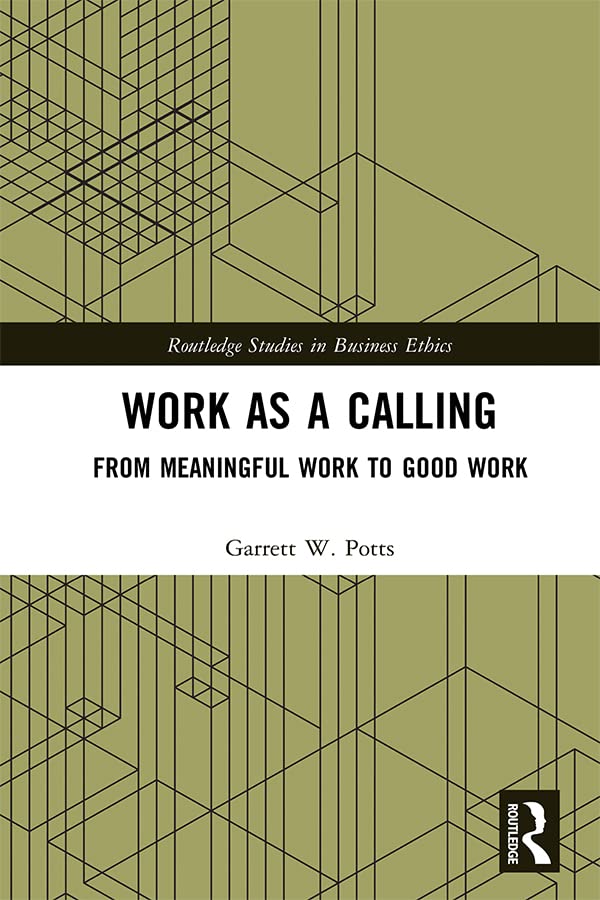
In Work as a Calling, Garret Potts (Professor in the Department of Religious Studies for Business & Healthcare Professionals at The University of South Florida) asks: ‘could it be the case that many modern people prevent themselves from experiencing the fulfillment that they hope for by focusing so much on themselves’ (page 16)? He answers this question by arguing for a return to the moral vision of work as a calling, whereby ‘meaningful work’ is ‘good work’ that pursues the common and individual good together. Influenced strongly by the work of Robert Bellah et al. in the sociological classic Habits of the Heart, the author contends that the view of the calling orientation found there has given way to a view of calling based on self-interested rewards and individualistic concerns about how workers feel about doing good work.
The first two chapters show how the major academic literature on ‘work as a calling’ can be seen to have departed from the vision of Bellah et al. The author points out that ‘Contemporary notions of work as a calling stress that work should provide individuals with a deep sense of meaning and personal fulfillment. Such notions demand that work ought to be a therapeutic source of individual happiness’ and that ‘notions of “meaningful work” are often divorced from moral considerations about (a) good work (i.e., the production of excellent products/services), (b) the good of individual lives (including one’s very own), and (c) the common good of communities that one’s organization reaches’ (page 14-15). Thus, much of the existing literature sees a calling as being bound to identity exploration, such that accounts are centred on subjective fulfilment as distinct from the pro-social dimensions and communal goods that characterised traditional understandings. Even those authors who are critical of this trend ultimately themselves lapse into the individualistic outlook, or end up using its vocabulary. All of the leading authors in this field, while acknowledging their debt to Bellah, ultimately adopt an individualist position that is incompatible with his approach – incompatible because such an outlook both reduces pro-social tendencies and over-emphasises personal autonomy, with the result that notions of the meaningful life, ‘often construed in a consumeristic way, have become divorced from considerations about goods that are necessary for individual and communal flourishing’ (page 51).
Chapter 3 is a dense, theoretically heavy chapter that shows how heavily influenced Bellah’s vision of the calling orientation was by the practice-based theory of the virtues propounded by the philosopher Alasdair MacIntyre. MacIntyre’s thought is complicated but in essence it sees virtues as excellences or dispositions of character that enable us to serve and achieve the internal goods of certain practices, sustaining those practices and helping us to flourish as individuals and communities. For example, architecture, as a practice, requires the achievement of certain types of excellence (professional and technical skill, the use of the right materials and so on) in order to bring about certain goods internal to the practice, such as excellent houses – rather than simply profit, which, though a good, is an external one. Where practitioners focus on external goods instead of the internal goods, they risk falling into certain kinds of vice (such as greed) and the practice suffers (with the construction of shoddy homes). As such, those genuine goods which enable us to flourish – as individuals, as communities of practitioners and as a society – lie outside of ourselves. Indeed, our preferences and desires need to be ‘tutored’, as it were; we have to learn, within a practice – a living tradition that is maintained and passed on with its own standards of excellence – and by deliberation with others over ends, what things are genuinely good, rather than focus on the fulfilment of those preferences that we do in fact happen to have. The author draws on this approach to distinguish between a true calling and a fake one: a true calling cannot ultimately be based on the individual’s un-schooled preferences, for ‘meaning emanates from one’s shared participation in good work that genuinely contributes to the flourishing of individuals and communities’ (page 60). A true calling cannot treat work as a means to personal fulfilment; rather, it must involve good work within a community of practice and sound judgement, which results in genuine goods, such that work has meaning and value in its own right.
The fourth chapter looks at the social implications of the fake, individualist calling. In the modern, Western world (particularly the U.S.) working as part of practice-based communities reflecting on genuine goods or ends that ought to be desired has given way to a focus on individual autonomy, and this has left the individual as the locus of value, with the preferences that he or she happens to have. This individualism – as expressed in fake callings which centre on maximising the satisfaction of preferences or expression of the self – is mirrored at the organisational level with a focus not on genuine goods to be pursued together, such as excellent products, but on ‘effectiveness’, by which is usually meant the maximisation of profit or production. In both individual and corporate life, ends are simply given, therefore, and all reflection is on the means of achieving them. In our Western society, these ends are shaped by consumerism, such that the meaning in life is not based on the development of virtues centred on individual and common goods, but on ‘achievement’, ‘self-realisation’, wealth, or making something of oneself at work. However, as the author points out, the individualist approach does not deliver what it promises, for it would appear that the more people pursue such forms of ‘fulfilment’, the less happy and meaningful they find their lives and work to be and the greater the incidence of problems such as anxiety, or the feeling of not being valued as a person by one’s employer (whose attempts to keep staff happy seem to consist of solutions that distract from dissatisfaction and restlessness at work, such as the provision of pinball machines or ping pong tables). Thus, there are various consequences of the ‘junk’ values on which contemporary fake callings are based, and the author connects them with the fragmentation of individual lives, for example, and the ‘burnout society’ described by the philosopher and cultural theorist Byung-Chul Han.
In the final chapter, in an effort to show how it is possible to reclaim the kind of life envisioned by Bellah et al., Potts gives several examples across various sectors (such as education, retail, food and drink and cybersecurity, among others) of what he, following Robert K. Greenleaf, calls ‘servant leaders’, who live in accordance with a true calling, focusing on the genuine goods of their work rather than their own untutored preferences. He outlines some of their characteristics – such as empathy, seeking to persuade rather than coerce, striving to build community, choosing service over self-interest, for instance – with a view to showing that a true calling orientation is possible. For each example, the author shows why the person is following a true calling, often referring to MacIntyrean notions – for example, reflecting on genuine goods, participating in a practice-based community, or providing an excellent service that benefits a community – or showing how that person embodies the characteristics of a servant leader.
The book is at its best in the two final chapters as the author turns to the ‘real-world’ effects of the misconceptions surrounding work as a calling and meaningful work. The discussion is very interesting and extends far beyond the very short and incomplete summary provided here. These chapters should be of interest to readers with general interests in such issues and could be read in isolation from the earlier chapters centred on understandings of Bellah and his reliance on MacIntyre’s thought, which themselves have a far more limited appeal. The analysis would suffer from such an approach, however, because it is in light of those earlier chapters that readers can see precisely why the individualist approach to work as a calling is mistaken and why it is associated with the societal problems identified by the author. Similarly, one can see why the servant leaders described by Potts are chosen as examples. While there is real value in chapters 4 and 5 for readers concerned with wider questions of business purpose and meaningful work, the book is clearly a scholarly volume, aimed at an academic readership. In its entirety, therefore, it can really only be recommended for those with academic interests in these areas, as well as some grounding in MacIntyre’s neo-Aristotelianism and Bellah’s sociology.
Work as a Calling: From Meaningful Work to Good Work by Garrett W. Potts was published in 2022 by Routledge (ISBN: 978-0-36-772441-2). 164pp.
Neil Jordan is Senior Editor at the Centre for Enterprise, Markets and Ethics. For more information about Neil please click here.
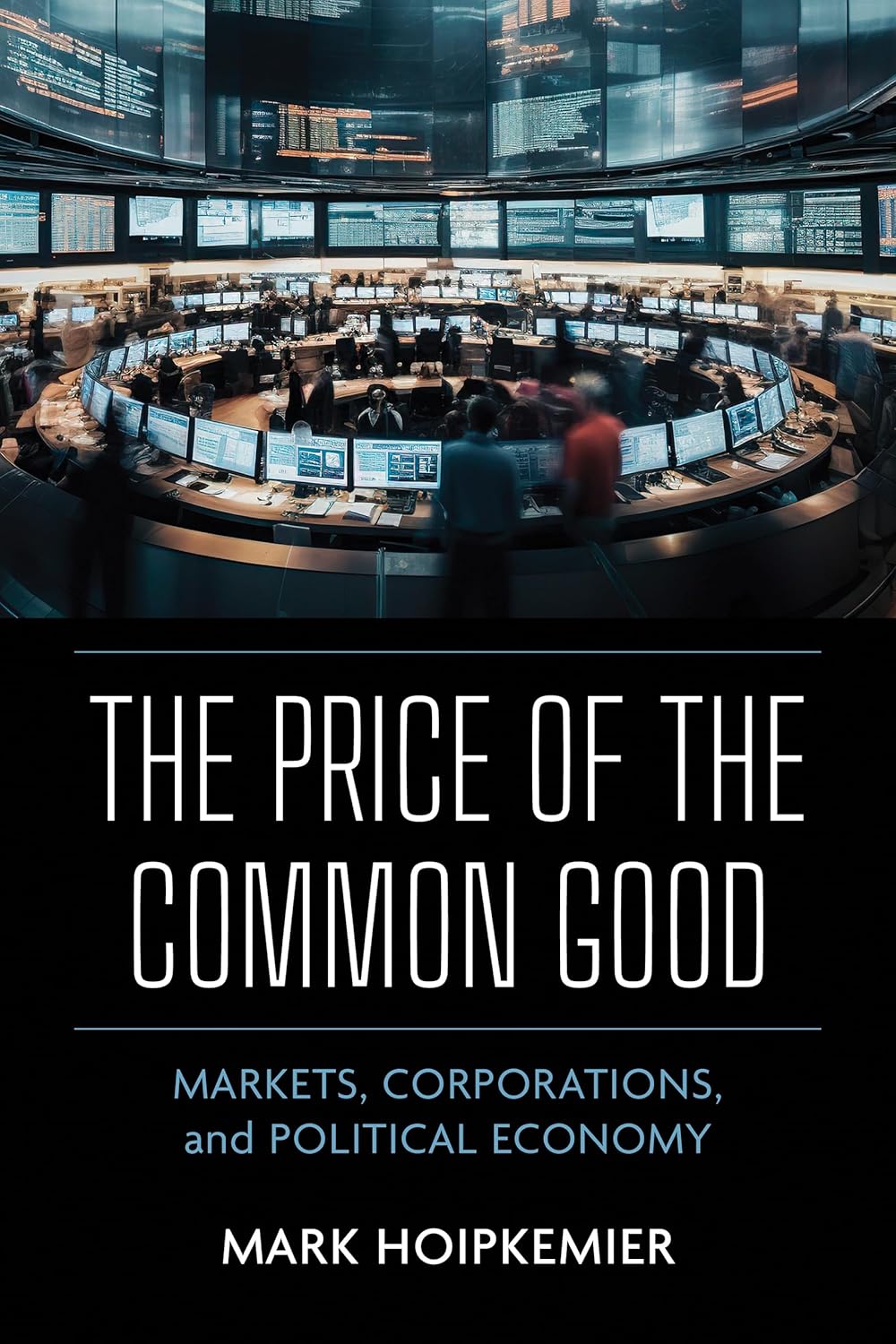
At a conference on business ethics a few years ago, an academic got up to reply to a presentation by a business leader. ‘That’s all very well in practice,’ he said, ‘but what about in theory?’ This book is a careful exploration of how in practice acting together in the service of common goods is more common than we sometimes think, and needs to find its place in any adequate theoretical account of both the firm and the market.
Hoipkemier has his sights focused in the first part of the book on the narrow conception of the firm as a nexus of contracts between self-interested actors (what he calls the ‘Chicago view’) . Such a view implies the firm is more like a market than a community, and he argues that ‘it’s wrong. It badly mistakes the social and legal reality of the firm’. He goes on to criticise Coase’s account of the firm in terms of cost-saving devices of transacting parties, noting that firms trade on the ‘trust and loyalty and shared culture that arise in human communion’. He argues that the firm’s claims of legitimacy ‘rest on relations of solidarity that demand to be treated as goods or values in themselves’, and that the economic advantages of co-operation ‘can be justly enjoyed only as common achievements … and not as private benefits’. He develops the idea of a firm as a community where membership implies participating in ‘a moral order that is a source of identity, fellowship and character formation’. This allows him to sharply distinguish employees as ‘members’ from shareholders and other stakeholders who have an interest in the firm but are not members of it. A supplier cannot share in the common good of the firm because ‘price centred market exchanges are not a form of common action’. He then interestingly explores the complexity of firms such as Uber where drivers are not employees but yet participate in the common good of the firm and have claims in justice on it.
The second part of the book is a fascinating exploration of how to understand and think about the market, and where in it – if at all – common goods arise. The author takes us on a journey through Hayek and Polanyi to Genovesi to explore the true nature of markets using a variety of examples, and asks whether and how the political institutions that underpin markets are themselves forms of the common good.
For Hayek the absence of common action or common goods in a market is essential, as it frees participants to focus on quality and price, and price signals in an efficient market contain all the information needed for buyers and sellers. Hoipkemier notes that Hayek’s framework, despite its depth of insight into the power of spontaneous order and the effectiveness of free markets, nonetheless suffers from a deficit in its account of how markets themselves depend on a shared political vision, a broader common project.
Here is where the insights of Polanyi are so relevant, in explaining how the development of markets is inherently political and historically conditioned, and has now escaped the boundaries previous cultures carefully erected. ‘What worried Polanyi, and should worry us still, is that the aspirations of modern liberalism have obscured this civic foundation and allowed the beneficial logic of the invisible hand to metastasise into an all-consuming ideology of the self-regulating market’. Polanyi was profoundly insightful and critical of what he saw as the commodification of people and land, and thought these needed removing from the market altogether, but his analysis was constrained by his assumptions about the limitations of market relationships, and the difficulty he also saw in finding better alternatives.
This is where the humanist vision of market relationships promoted by Genovesi and in recent times by Zamangi and Bruni comes in. Genovesi sees market relationships as ‘a domain of cooperation as well as competition, a sphere of solidarity as well as contract.’ With a different anthropology, market relationships become ‘a site of fraternity where the dominant intention aims at mutual assistance for the sake of a common good rather than interdependent private benefits’. Interestingly, Hoipkemier then speculates on how such a richer commitment in market relationships could be signalled through ‘social co-efficients’ – adjustments to prices to reflect an obligation or gift as well as an entitlement. Attractive as it is, he is also clear about the difficulty of simply generalising this humanistic vision to the wide variety of market relationships from local to global.
The governing theme of the whole book is that a grammar of the common good unlocks a more realistic understanding of how human beings participate in both firms and markets. Hoipkemier carefully carves out a specific and limited project here under the title of ‘Aristotelian pluralism’. He is not seeking to settle larger questions about the ultimate common good of society or human flourishing. Rather, by simply recognising that there are patterns of common action to common ends always involved in both firms and markets, he is seeking to expose the limitations of approaches that focus entirely on profits and private gain.
This second half of the book is excellent in drawing out the practical alternatives to the still prevailing narrow orthodoxy of market relationships, and how with a richer anthropology and better grasp of historical context, we are much freer than we sometimes think to re-imagine what market relationships could be, and how they could serve a broader common good. Many enlightened businesses, for instance, describe the shift they seek to make in moving from ‘transactions to relationships’, signifying a desire to broaden their sense of the shared worthwhile endeavour to embrace key suppliers, major customers and other stakeholders. How market relationships develop can be complex and varied, but Hoipkemier’s account helpfully draws out the fact that markets are always culturally and socially conditioned, and that we are not the prisoners of some deterministic Darwinian jungle where the only rule is narrow self-interest.
The first part of the book is somewhat less successful. A critique of the Chicago view of the firm is certainly needed, and the retrieval of the idea that common goods are generated and relied on in mainstream business activity is important. But simply saying ‘it’s wrong’ somehow misses the point – it may not be supposed to work in theory but it has been and remains powerful in practice. Some firms, particularly in the financial sector, have in their own terms succeeded: the model is designed so that individuals seeking no more than their own self-interest will behave in a way that enables a firm to maximise its profits. Such firms can and do survive, delivering high profits for investors over time in highly competitive and sometimes toxic working environments. Do they also only succeed through creating and relying on forms of common action that they ignore or deny? To some degree yes, no doubt, but enlightened self-interest in pursuit of private gain is often a prime motivator and plausible explanation for much of what they do.
Rather than claiming ‘it’s wrong’, a different approach would be to posit that there is a choice about how to understand the role of business in society, and how to think about people and what motivates them. The Chicago approach is clear that the role is to maximise profits and the motivation is self-interest. Because we are all malleable, the power of these ideas shapes what results. If we stay in a firm where these ideas are prevalent we are likely to adapt, and the resulting behaviour then reinforces these ideas. But this is a choice, an appeal to a limited view of the firm, and a narrow conception of people.
An alternative choice is that the role of business is to benefit society and that people are more than self-interested. These ideas also shape what a firm can be, and the nature of the social reality that comes into being. It is this alternative view of the firm as a social organisation where the flourishing of people is an intrinsic part of its purpose in society that enables common goods to be both fully recognised and also created. But this also depends on a second dominant idea, namely the operative view within a business of what motivates people. Is it just money, status and power, or are there other desires and motives beyond these, such as meaning, relationality and autonomy? As Sumatra Ghoshal points out in his classic 2005 paper: ‘Bad management theories are destroying good management practices’. Alongside a narrow view of the purpose of the firm, a highly individualistic and distorted view of what it means to be human is also a core problem, and has deeply distorted how business leaders think and act.
Hoipkemier brings this anthropological question out very well in the final chapter of the book in the discussion on markets, but it really needed to come at the start. In practice, the strategy and culture of a business are chiefly shaped both by the operative purpose (What is the point of the firm in society?) and also by the quality of relationships it cultivates based on its view of people and its assumptions about what motivates them. Alongside the recognition that common goods arise within firms when there is common action to a shared end, a better anthropology is also needed to recover a more realistic view of the firm as a social organisation where people matter, and want to contribute to a shared, worthwhile endeavour. This double shift in thinking is what can help create a better business, that is also better for society and better for people.
The book is not an easy read, but is carefully crafted and draws on a broad range of sources. In bringing the theory back to practice it would have benefited from references to purpose-led businesses and movements such as the B Corp, which illuminate the shifts in thinking taking place now as many businesses rethink their role in societies facing profound social and environmental challenges.
‘The Price of the Common Good: Markets, Corporations, and Political Economy’ by Mark Hoipkemier was published in 2025 by Notre Dame Press (978-0-268-20897-4). 304pp.
Charles Wookey is an independent consultant and business school teacher. He was a co-founder and CEO of the charity A Blueprint for Better Business, formed after the financial crisis to help create a better society through better business, and now supports its work as a trustee.
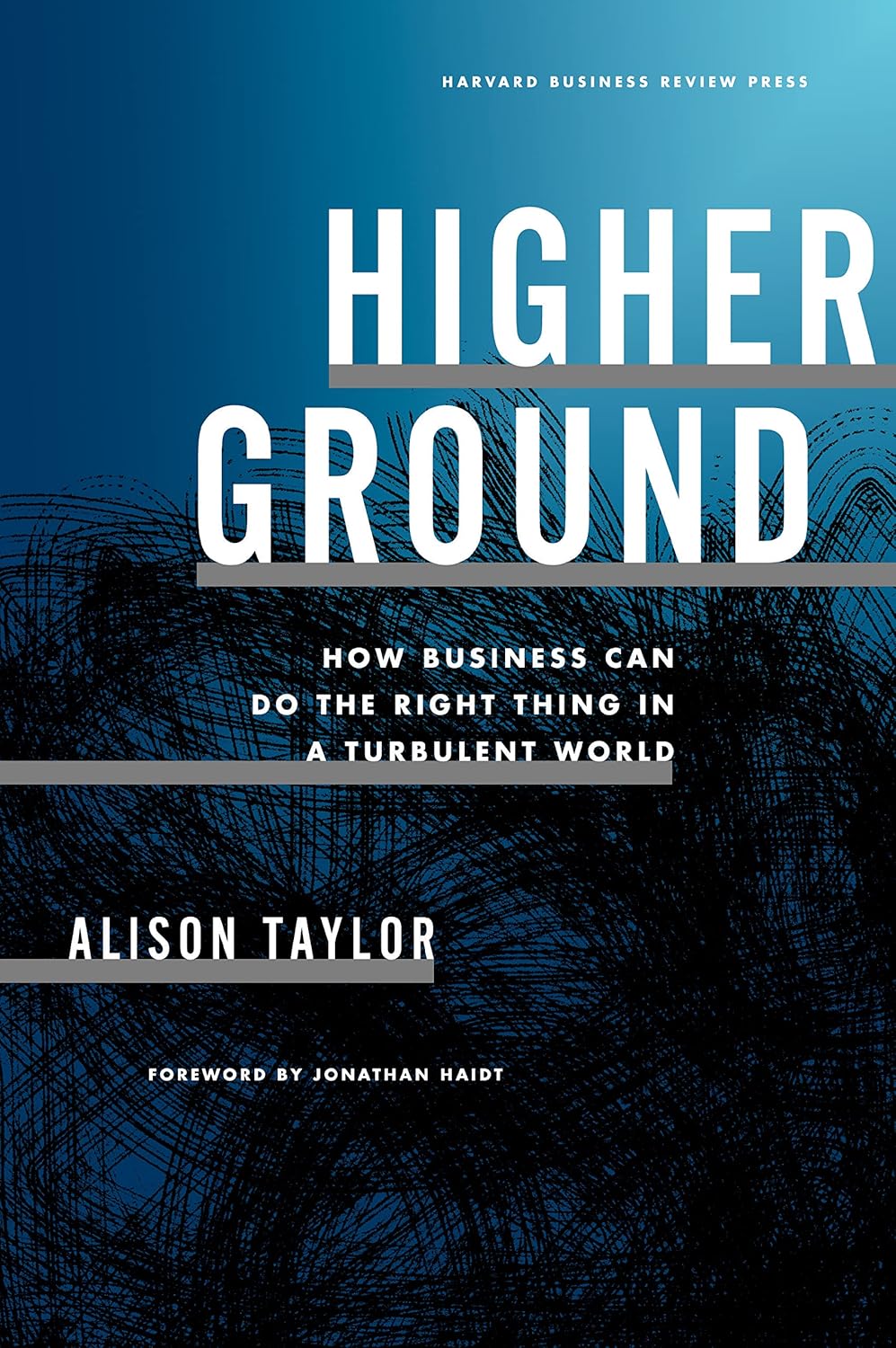
Alison Taylor, in her new book Higher Ground: How Business Can Do the Right Thing in a Turbulent World, offers practical advice to business owners and executives on how to navigate the choppy waters of business leadership in the 21st century, which includes trying to please everyone from customers, vendors, shareholders, activists, regulators, policymakers, and employees, to anyone with an influential social media account. It is an exhausting and impossible task that creates distractions and pulls executives in unobtainable directions. Taylor is a clinical professor at the NYU Stern School and has years of experience consulting large multinational corporations on matters such as organizational risk, corruption, and navigating the strange business world that we find ourselves in today, which she rightly describes as turbulent.
The book is divided into three parts. Part I begins with an explanation of why everything became so chaotic and complicated. Part II offers advice on how businesses can do the right thing, which includes dealing with building stakeholder trust, tackling corruption, understanding the human element, dealing with transparency without worsening the situation, and tackling corporate political responsibility. Part III provides advice on corporate leadership into the future. Taylor argues this requires a more curious and dynamic corporate culture that eschews top-down control and values ethical leadership in the C-suite, which has appropriate checks and balances.
Long gone are the days when you were on a first-name basis with the local hardware store owner. We live in a world of trillion-dollar companies that create vast social and material value; however, both large and small companies are increasingly pulled in contradictory and chaotic directions. A company that attempts to serve everyone will likely fail in fulfilling its most important mission: serving its customers. This is where many will take issue with the author.
She wastes no time disputing Milton Friedman’s claim that the social responsibility of business is to maximize profit within the boundaries of the law. This comes from both Capitalism and Freedom and his famous 1970 New York Times essay where he argues:
‘The short‐sightedness is also exemplified in speeches by businessmen on social responsibility. This may gain them kudos in the short run. But it helps to strengthen the already too prevalent view that the pursuit of profits is wicked and immoral and must be curbed and controlled by external forces. Once this view is adopted, the external forces that curb the market will not be the social consciences, however highly developed, of the pontificating executives; it will be the iron fist of Government bureaucrats. Here, as with price and wage controls, businessmen seem to me to reveal a suicidal impulse.’
Ironically, in 1970, Milton Friedman predicted the chaotic environment in which corporations find themselves today. Most of the anecdotes Taylor documents throughout the book are occurring because we did not heed Milton Friedman’s advice.
Taylor is correct that businesses are pulled in too many directions and cannot possibly be all things to all people. The Coasian theory of the firm is not dead—the firm has boundaries regarding what it can accomplish based on transactions costs. Yet, throughout the book, a tension remains regarding what the author would like corporations to accomplish and the clear absurdity of what firms face today from every angle. She is correct when she argues that focusing on human beings, fostering a corporate culture of respect with open feedback loops, thwarting corruption, and overcoming executive blind spots are immensely important.
We live in a social media-driven world, where a single corporate email can become a viral TikTok trend that takes down a company. Taylor is correct that corporate culture and leadership must be priorities for businesses, as one business alone cannot solve all political issues within its industry, and it should not use legal and regulatory rules to serve its interests. Taylor affirms this, yet, firms distort and manipulate the legal rules of the game all the time.
Taylor is not an economist, and as such, this book is unable to address some of the very problems it seeks to confront. It begs for public choice analysis. In the introduction, she reasonably claims that business has become increasingly political, which causes internal conflict and problems. She later dedicates a chapter to navigating the political process more effectively. Taylor suggests that companies may need to argue for ‘shrewd regulations which level the playing field.’ Still, this almost always creates snowballing regulations, which are socially costly and distract businesses from serving their customers. Taylor appears to understand the threat of cronyism, citing research that demonstrates a negative relationship between corporate political investment and market valuation (page 131), but understates its pathologies, believing that companies can remain neutral while engaging in political matters.
We must always count the costs and be aware of potential unintended consequences. One is the formation of the Iron Triangle, where special interest groups, bureaucrats, and policymakers align in such a way that outsiders cannot assert any influence or change those symbiotic and preferential relationships. Moreover, the author makes assumptions about which political and corporate matters are essential based on her more progressive worldview.
She assumes measures to address climate change are valuable, that ESG has been maligned as an ‘ideological, “socialist” movement,’ that environmental and social responsibility ‘is always good for the bottom line,’ and that healthcare is a human right. Yet, there is wild disagreement on these claims. Taylor understands that when a firm chooses a side on any of these issues, some backlash is inevitable. Yet her point of view argues that these progressive causes are worthy, but that Republicans and conservatives try to block them at every turn, and she seems somewhat critical of capitalism itself. These vantage points are the basis for her somewhat technocratic approach to using regulations productively. The economic way of thinking, if employed, would force her to put these assumptions to the test of cost-benefit analysis.
Taylor (page 30) invokes the controversial Larry Fink, CEO of BlackRock, who has made the social and political case that business must ‘show how it makes a positive contribution to society.’ Taylor implies Republicans have unfairly targeted Fink, yet some would argue that he is imposing a social agenda outside the rule of law and has created vast personal wealth in the process. This appears to be cronyism on full display. Taylor points to the Boeing 737 Max scandal as an example of why Friedman was wrong, because maximizing shareholder value might lead one to defend corporate political spending to reduce regulatory burdens. Taylor implies that avoiding this crisis requires either more or better regulations. This, however, is actually a problem of incentives. If Boeing has captured the regulators who are charged with ensuring its operation is safe, then, rather than advocating for more or better constructed regulations, the only corrective is to disentangle these political and corporate interests.
Yet, Friedman argued that we should get back to the basics. Firms do their best when they make a profit and operate within the rules of the game. This is not to suggest that we do not face real problems in the world. Environmental concerns are real and require creative solutions. Human rights issues abound around the globe, and firms must ensure they are acting with integrity, as corruption can be a powerful intoxicant.
This book wrestles with real problems. Yet Friedman is vindicated even though Taylor thinks his argument is no longer enough. Taylor (page 134) succinctly characterizes the pressures businesses face today: ‘We’ve all begun to expect action on the issues of the day from brands we patronize. We cannot possibly keep track of all the issues and corporate stances, let alone consistently and effectively reward or punish companies via our spending or in statements we post on social media. This illusory process has lured us down a side trail of unrealistic expectations. It redirects valuable energy that’s needed to run businesses and responsibly manage operational impacts. It distracts the public from pursuing healthy political endeavors.’ There is much to agree with in this statement, but doesn’t it vindicate Friedman’s warning?
Business exists to serve the demands of consumers, and consumers are fickle. They always want things faster, better, and cheaper. The goal of a firm is to serve its customers and uphold the rule of law. The more firms diverge from this and try to wade into political and regulatory battles, the more they invite the government into their business, causing them to lose sight of value creation and distorting their incentives to create social value.
Firms operate through property rights, profits and losses, and prices, but government intervention distorts these signals and incentives. Economists agree that firms should be free to advocate for any issues they care about, yet this freedom often leads to disagreement, as Taylor points out. Lines will be drawn in the sand, so maybe companies should talk less and innovate more. This book addresses timely, complex, and important matters of corporate governance. Taylor offers sound practical advice when it comes to remembering that one firm cannot do everything, that political battles are divisive, and that we must focus on a humane corporate culture. Perhaps returning to the basics is the best way to navigate complex and multinational corporations in this digitized and globalized world.
‘Higher Ground: How Business Can Do the Right Thing in a Turbulent World’ by Alison Taylor was published in 2024 by Harvard Business School Publishing (978-1-64-782343-6). 304pp.

Anne R. Bradley is the Vice President of Academic Affairs at the Fund for American Studies. She is a professor of economics at the Institute of World Politics and an affiliate scholar at the Acton Institute.
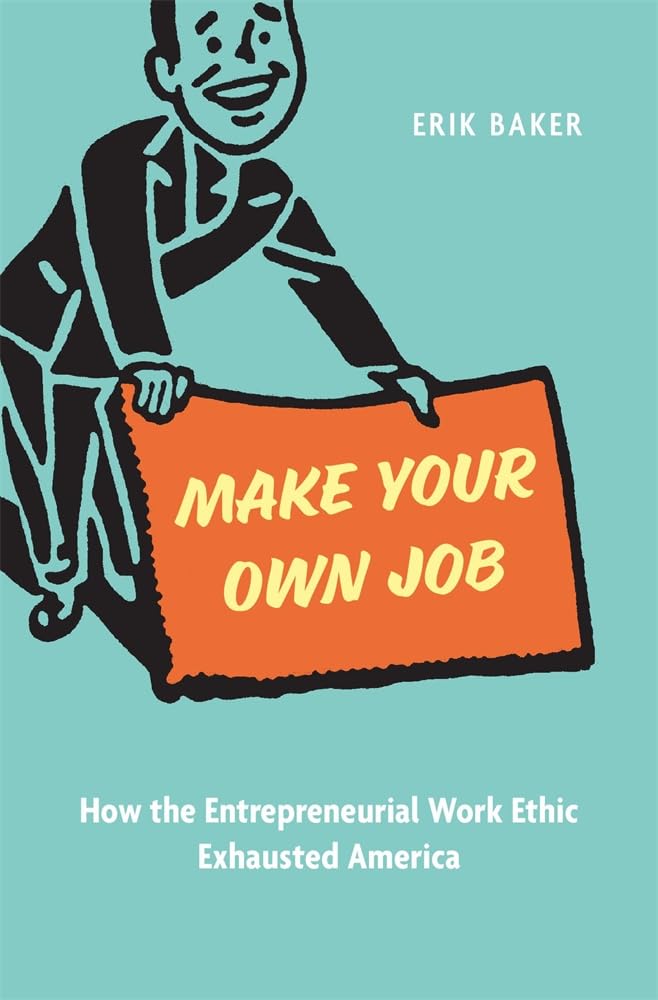
It takes a brave person to challenge one of the consensus beliefs of a society, but that is precisely what Erik Baker does in, Make Your Own Job: How the Entrepreneurial Work Ethic Exhausted America. His book puts firmly in its sights ‘the idea that everyone should strive to be entrepreneurial’ which he promotes to the status of a ‘work ethic’ that ‘promises material rewards and intangible benefits’ but drives a ‘spike in burnout and despair’ and an ‘epidemic of exhaustion’ (page 3). The book gives a grand historic sweep of corporate America from Henry Ford’s adoption of the ‘New Thought’ Movement in the 1920s to the ‘Great Resignation’ of the 2020s.
At each stage on this industrial timeline the thought-provoking question is how entrepreneurial strategies and activities bred an entrepreneurial work ethic which became so embedded that it was adopted as assumed wisdom for all, rather than the choice of a few. His issue isn’t with entrepreneurs but with ‘our collective commitment to entrepreneurialism’ which he suggests isn’t helping because ‘it enjoins us to work more intensely than we need to and leaves us feeling devoid of purpose when we don’t have work, or the right kind of work, to do’ (page 3). But I couldn’t help replying, ‘Really?’ Is the core proposition proven that entrepreneurial work and making your own job leads to an innate drivenness and risks profound emptiness not experienced by those who work in corporate structures? This doesn’t take away from the fascinating content but does add a warning label that the historical overview needs processing and applying.
One strength in the book is the rich historical detail that deconstructs the beliefs of industrialists, politicians and thought leaders and shows how strong an influence they have had on our attitude to doing work we love – a phrase that is common on co-working walls but is attributed to Elizabeth Jones Towne in the 1900s with phrases such as ‘A man’s success is measured…by the amount of LOVE he feeds his work with’ (page 33). What the book left me wondering however was what other work ethics were at play and how they also impacted our view of entrepreneurial endeavour. Puritan New England is mentioned as an ethic that denied ‘desire and selfhood’ (page 33) but is quickly dismissed as a ‘baleful, anachronistic influence’ in contrast to the success-orientated New Thought luminaries, such as Towne (page 33). If religion is referenced at all it is in a thread throughout the book which separates the new mechanical ideas of business efficiency from the ‘extra endowment’ of ‘foresight – the philosophic power of understanding the complex flux of the varieties of human societies’ (page 56). The idea of a ‘divine energy’ which ‘releases in man a power and a force beyond human capacity to generate’ (page 87) was made popular by Norman Vincent Peale, author of The Power of Positive Thinking in 1952. The glaring gap is the teaching from religion about the purpose of work as a gift from God and part of his eternal purposes. If work is about channelling our own energies, then it is not surprising that we will get exhausted. But when we work with all God’s energy working powerfully in and through us (Philippians 2:13), then we will be restored and enjoy meaningful work and Sabbath rest!
The book is a detailed survey from an almost exclusively USA perspective. This shouldn’t be surprising as the title gives due warning of which side of the pond it’s placed, but it did mean that some transatlantic translation is necessary. The experience of the Blitz and ‘labour’s not working’ election posters are just two amongst many British cultural moments that shape our attitude to work and entrepreneurship. The description of Sun Belt entrepreneurs as a ‘Promethean master race’ full of ‘good-looking, healthy, superior Americans’ (page 114) is slightly at odds with the picture of people in 1960s Britain – the creative energy was there but it looked very different and shaped an entrepreneurial work ethic very differently. By its nature, the book focuses on some aspects of corporate America which help tell the story of an entrepreneurial work ethic, but I’m sure many other threads to that story could be added. One striking insight is how much influence Harvard Business School had in shaping the corporate mindset and several professors are frequently quoted. Since the author is a lecturer at Harvard it is less unexpected but still noteworthy, especially as the influence from and on academic institutions is in a liminal phase right now.
The later chapters describe the entrepreneurial philosophy of Steve Jobs and the rise of ‘philosopher-kings’ (page 163) who thought very differently from the academics in the elite east coast business schools. In contrast to the accepted wisdom, Steve Jobs focused on the intersection of the arts and the sciences, and the conservative executives of middle America emphasised ‘the analogy between the entrepreneurial firm and the patriarchal family; the entrepreneurial leader as a paternal authority; the entrepreneurial work ethic as an expression of faith in God and country’ (page 164). The contrast in the ways the power of entrepreneurialism is applied in the lecture halls of Harvard, the Silicon Valley offices of Apple and the training institutions set up by business leaders in St Louis, is a helpful reminder of how people shape very similar ideas with very different worldviews.
As our narrative timeline propels towards the present there is a fascinating focus on social entrepreneurship – a current phenomenon well worth studying in its historical context. If the outworking of the entrepreneurial spirit’s drive is exhaustion and the enforcing of ‘unforced enthusiasm’ amongst those who ‘survived the cut’, are in ‘the winners circle’ and working ‘extreme jobs’ (page 189), there is a useful exploration of how gain of other types of value legitimises entrepreneurial purpose. One conclusion, which I’m a big proponent of and is the focus of my research, is to reevaluate what we mean by value and what we are therefore applying our entrepreneurial energies to generating. But the conclusion that seems more favoured here is that it is inevitable to create ‘duds of the new economy’ as ‘a significant fraction of the population was condemned to be economically valueless’ (page 231) while the elite are just plain exhausted.
The ongoing tension is in the starting hypothesis. If the entrepreneurial work ethic is causing exhaustion because it ‘leaves us feeling devoid of purpose when we don’t have work, or the right kind of work, to do’ (page 3) what alternative would give meaning and renewing energy? The answer, which many theologians not mentioned in this book have suggested over the centuries, is to find purpose in serving an entrepreneurial God who is creative, redemptive and holistically entrepreneurial.
Would I recommend this book? Yes, to a specific audience who have interest in the story of entrepreneurship or to an engaged audience who are willing to apply the history from a land far away, and in some parts a time long ago, to the present challenges of work. Don’t expect ready answers to exhaustion, but do explore the many reasons in the history of corporate America why doing what we love has become the new religion at work.
‘Make Your Own Job: How the Entrepreneurial Work Ethic Exhausted America’ by Erik Baker was published in 2025 by Harvard University Press (ISBN: 978-0-67-429360-1). 337pp.

Andrew Baughen is a management consultant specialising in mapping the whole value of organisations. He researches business worldviews and teaches ethics at Bayes Business School and is also an associate minister at St Margaret’s Lothbury.
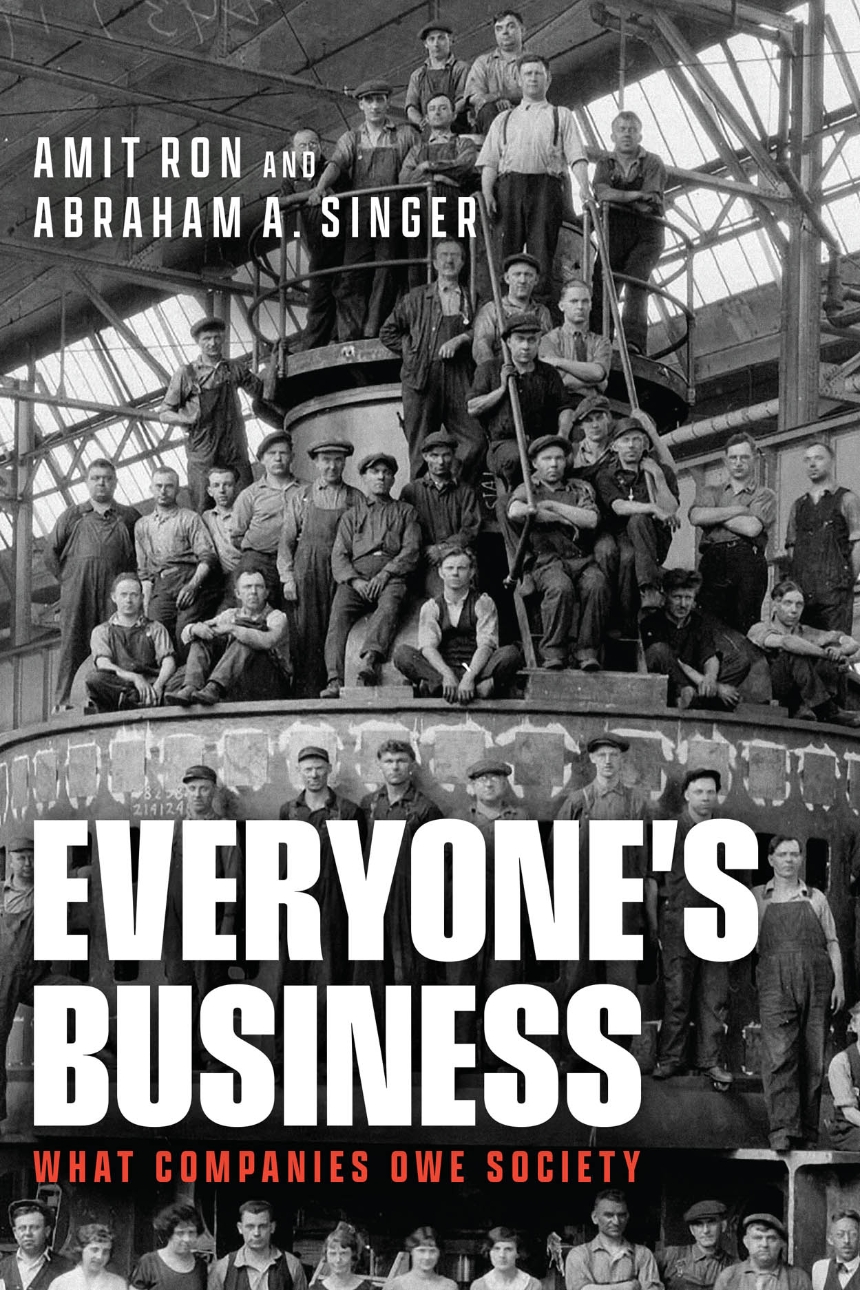
Approaching a new book on the recurrent and vastly researched question on the responsibilities of business towards society, readers might wonder where the novelty might be. In Everyone’s Business: What Companies Owe Society, Ron and Singer take a specific perspective to solve the old (and still relevant) question and apply a novel lens to provide answers: readers will not be disappointed. The authors, from their point of view as ‘political theorists’ (page 18) and openly (and critically) from ‘the left side of the political spectrum’ (page 11), explore the political dimension of business activity, with a specific focus on the concept and practice of power. Ultimately, the authors work to develop the idea that business has a responsibility towards democracy, which translates into an obligation to respect those processes which confer on business the position it has.
Overall, the book makes for good reading, and is well structured, written and presented. There is clearly a conceptual density, to the point that each chapter can be commented on in itself regarding the content and the selection of the literature that the authors offer. For this reason, this review presents a brief synthesis of the first chapters, where the authors present their theory, then it provides a glance at the remaining chapters with a more specific focus on one of them (Chapter 5), to give an idea of how the authors put their approach into action.
The Introduction offers a concise, ordered, and logical synthesis of the main lines of argument of the book. It presents an exhaustive preview of the book. It introduces the research question and the starting point of the authors’ research: ‘we take the problem of corporate power, and the threat that power poses to democracy, as the starting point for thinking about business ethics and corporate social responsibility. What obligations do businesses have given their place within societies aspiring to democratic systems of governance?’ (page 3). The Introduction also provides a preview of an essential construct for an understanding of the book: the authors see business activity as a ‘social subcontract’ (page 5). They present commerce as an organized ‘sphere of social activity’ (page 6), that society itself establishes, conferring on it a degree of autonomy with the purpose of contributing to social ends.
Chapter 1 provides an enjoyable anthology of approaches to business ethics, and a re-reading of them as theories of power. Profit-maximization, stakeholder theory, social contract theories, and also political corporate social responsibility and market failure approaches are presented in terms of corporate power. There is also a final table (page 47), which gives visual evidence of the structure followed by the authors in building their perspective throughout Chapter 1. The other chapters would have probably not allowed for a similar synthesis, but it is highly beneficial at the end of a dense chapter to be gifted a structured table to appreciate the content at a glance. All these theories, according to the authors, leave unaddressed important questions regarding different dimensions of corporate power. Ultimately, the authors want to show that a functioning democratic society is able to host a functioning business and make it work for social ends, and that the dynamic of power between business and society sheds light on how this can happen. Chapter 1 concludes with a good synthesis of what one of the main contributions of the book is: ‘If business ethics is fundamentally about constraining the power that businesses possess, and democracy is an essential background process for determining what aspects of that power need to be constrained and how, then businesses’ ability to affect and undermine democratic processes is a crucial topic for business ethics to consider, which the theories on offer, despite their many strengths, don’t quite address’ (page 48).
Therefore, and this leads to Chapter 2, the authors start building their own contribution, making their way to outlining the obligations that businesses have towards democracy. They take more space in this chapter to define the idea of business as ‘social subcontract’ (pages 50-51), which entails the existence of obligations attached to the social position of businesses but also attached ‘to the political processes that determine their social position’ (page 51). The authors define those as second-order obligations. They then provide a definition of democracy and finally outline principles for democratic business ethics.
After a chapter dedicated to the rule of law and related ethical obligations (Chapter 3), the authors show how to apply their principles for democratic business ethics to contexts where democracy is potentially undermined. Therefore, they present lobbying (Chapter 4), as a form of undermining formal democratic procedures; marketing (Chapter 5) and activism (Chapter 6), as ways of undermining informal democratic procedures; and they conclude with forms of undermining democratic relations (Chapter 7 and 8), taking into account relationships in the workplace and between businesses and communities.
As the content of each chapter is very dense, readers can navigate the chapters according to their interests. Here, a quick preview of the chapter on marketing (Chapter 5) is offered. Marketing is integral to current market practices, and it has a very wide and diverse reach. The authors here are worried about how marketing influences the processes and structure of a deliberative democracy, where the accent is on the engagement of citizens in the formulation of ideas, positions, reasons and in good debate. Marketing is in a position to influence deliberation, and also to influence what citizens think about politics, for example. From this perspective, the omnipresence of advertising in citizens’ everyday lives comes under the spotlight in the second half of the chapter: the authors present compelling cases regarding ad placement, the creation of stereotypes, product placement and the erosion of trust (pages 120-125). They conclude with four short cases regarding product placement: these examples show, in different degrees, that businesses, by penetrating the public sphere with advertisements designed not to be perceived as such, have the power to undermine the essential trust ‘needed for a reasoned exchange of ideas in the public sphere’ (page 124).
Looking at possible criticisms regarding this book, the authors state that they aim to ‘introduce the uninitiated’ (page 18). While commendable, the level of the book is clearly higher than a completely uninitiated reader could digest. This does not mean that the book is not clear. On the contrary, the authors do a tremendous job in summarizing complex theories and selecting the elements they need to advance their thesis, in an ordered and logical way. Nevertheless, approaching the book in possession of some degree of familiarity with the existing theories on the relationship between business and society would clearly help with navigating the work’s complexity.
To close the loop, of course there is always something more and something else to theorize in a crowded and well-researched field. Ron and Singer, well aware of the ‘sheer volume of discussion about what businesses owe to society’ (page 2) show an extremely good mastery of the complexity of this interdisciplinary exploration and deliver a novel output of praiseworthy specialized academic quality.
‘Everyone’s Business: What Companies Owe Society’ by Amit Ron and Abraham A. Singer was published in 2024 by The University of Chicago Press (ISBN: 978-0-226-81938-9). 234pp.

Marta Rocchi is Associate Professor of Business Ethics at DCU Business School, Dublin City University, Ireland. For more information, visit her webpage here.
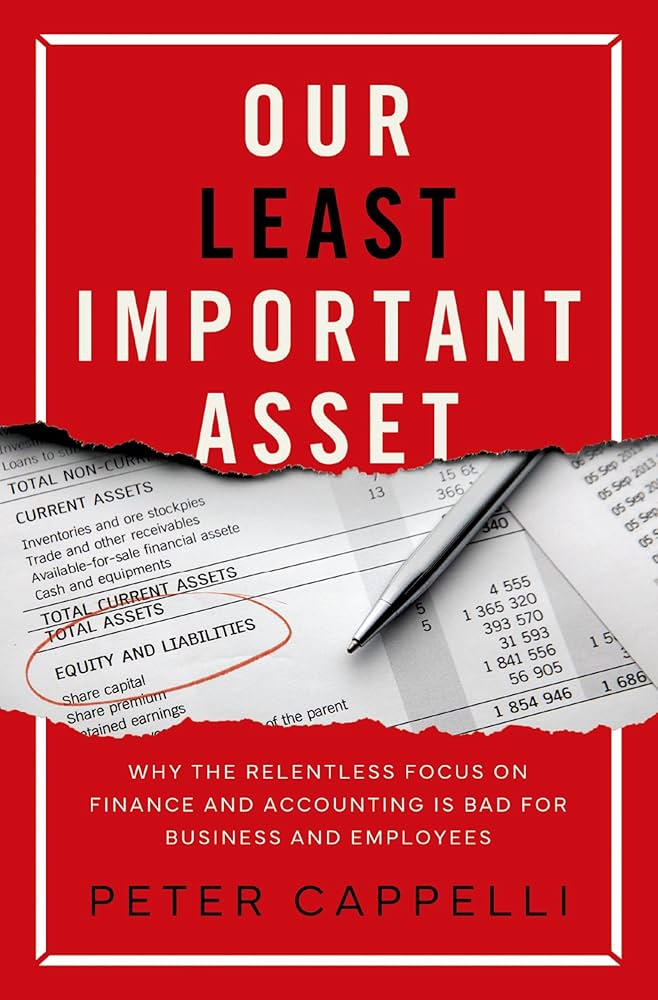
Peter Cappelli is the George W Taylor Professor of Management at the Wharton School of the University of Pennsylvania and has written extensively on the management of employees. In this book he identifies what he regards as a decline in the quality of management, particularly by large organisations of their people. Elements of this include a failure to train existing staff, to undertake effective succession planning and a generally lower priority given to the recruitment and development of employees.
Few would argue with the importance of managing people well or challenge the difficulties of doing so effectively and consistently. Cappelli attributes a marked decline in the quality of people management to both the mechanics of and the importance attributed to financial accounting. While his analysis is flawed, his suggestions for reform have merit. He suggests disclosure of the staff turnover rate and of the amount spent on training. Additional disclosure requirements, given the current length of annual reports, need careful consideration, but a business which is reliant on a highly skilled workforce should be focused on those metrics. Investors can reasonably be expected to find that information helpful.
Brief interesting suggestions at the end of the book cannot disguise the fact that the overall analysis is flawed, both in the detail of accounting and in the impact it has in a business. The author’s argument is that financial accounting drives business decisions, and as it fails to reflect the value of people, those decisions too often fail to consider the impact on employees. His concerns are not without some basis. Recruitment and training costs are current expenses and not spread over the life of the employment, while the costs of a tangible asset are spread over its life. Staff generally do not meet the accounting definition of an asset so that costs, which may have a benefit over a longer period, are expensed as they are incurred.
However, Cappelli both misunderstands the detail of accounting and exaggerates the impact of financial accounting on decision making. He demonstrates his grasp of accounting by commenting that, ‘liabilities are arguably worse than expenses on a balance sheet in that they continue into the future’. He rightly recognises the importance of post-retirement benefits, and the shift from defined benefit to defined contribution schemes. However, rather than considering the impact of increasing longevity and changes in discount rates, among other factors, he blames the accounting, ‘Moving from defined benefit plans to defined contribution plans … immediately make(s) a company appear more valuable because liabilities of future obligations (sic) go away’. To state the obvious, a change in prospective pension arrangements has no impact on an existing liability. Perhaps most frustratingly, while recognising that, particularly in the US with very limited notice periods, labour costs are not a fixed cost, he repeatedly complains that they are treated as if they were. The repeated misunderstanding of accounting is frustrating. What is worse is that it leads to a muddled and simplistic analysis of changes in the way that people are hired and managed.
Building on his flawed understanding of accounting, Cappelli assumes that financial accounting drives decision making. There is no recognition of the way that businesses, while taking the accounting impact into account, evaluate a range of issues in making a decision. In particular, Cappelli argues that there has been an unnecessary focus on reducing labour costs. None of ‘offshoring’, ‘China’ nor ‘productivity’ appear in the index. To write about the US labour market without recognising the impact of the rapid growth of the availability of lower cost labour in Asia is a surprising oversight. The reality is not that US companies have simplistically been driven by accounting to reduce labour costs, but rather that they have been responding to fundamental changes in the global economy. Sadly, this book is overly simplistic and adds little to the debate on the way that the labour market has changed.
Perhaps the most disappointing element of this book is the tone of regret for a past world where personnel departments had large budgets and exercised significant power. Cappelli harks back to the time when human resources was regarded as the ‘most glamorous’ business function. Apparently without irony, he regrets that most startups begin without ‘structured management practices and human resource expertise’. It might have been worth considering the extraordinary success of US start-ups, and whether their success might reflect a focus on their product or service rather than the glamour of human resources. The success of the US economy in generating growth might suggest that the decline in emphasis on human resources has not been entirely disastrous. Cappelli leaves the unfortunate impression of an academic who has seen his area of expertise sidelined, and rather than seeking to understand why this has happened, has sought a villain to blame.
This is a missed opportunity. There is much to consider in the ways that the labour market has developed in recent years. In Western economies a trend towards services and away from manufacturing, combined with significant changes in education, have contributed to a workforce which is markedly more mobile, while the gap between the expectations of staff and the reality of work has widened. Very recently, the rise of home working has raised new challenges for management. If it is possible to work from home, how does management reconcile the need for employees to feel trusted with effective control, particularly of poor performance? Given that in a service environment skills are frequently transferable, how does a business justify training, if that simply makes it easier for an employee to benefit from a pay rise elsewhere?
Rather than challenge an inappropriate reliance on accounting, Cappelli has reinforced the sense that too often human resource departments became divorced from the reality of the business and too concerned with their own agendas. This is unfortunately a book which seems to tell us more about the concerns of the author than add to the debate on an important and difficult topic.
‘Our Least Important Asset : Why the Relentless Focus on Finance and Accounting is Bad for Business and Employees’ by Peter Capelli was published in 2023 by Oxford University Press (ISBN: 978-0-19-762980-2). 240 pp.

Andrew spent his career with PricewaterhouseCoopers where he was a partner for more than 25 years. He led a variety of the firm’s businesses both in the UK and globally, with a focus on the pharmaceutical industry. He also led the firm’s work on explaining corporate taxation to civil society and the public. He is now studying for a masters in history which he combines with being a trustee at the London Handel Society.
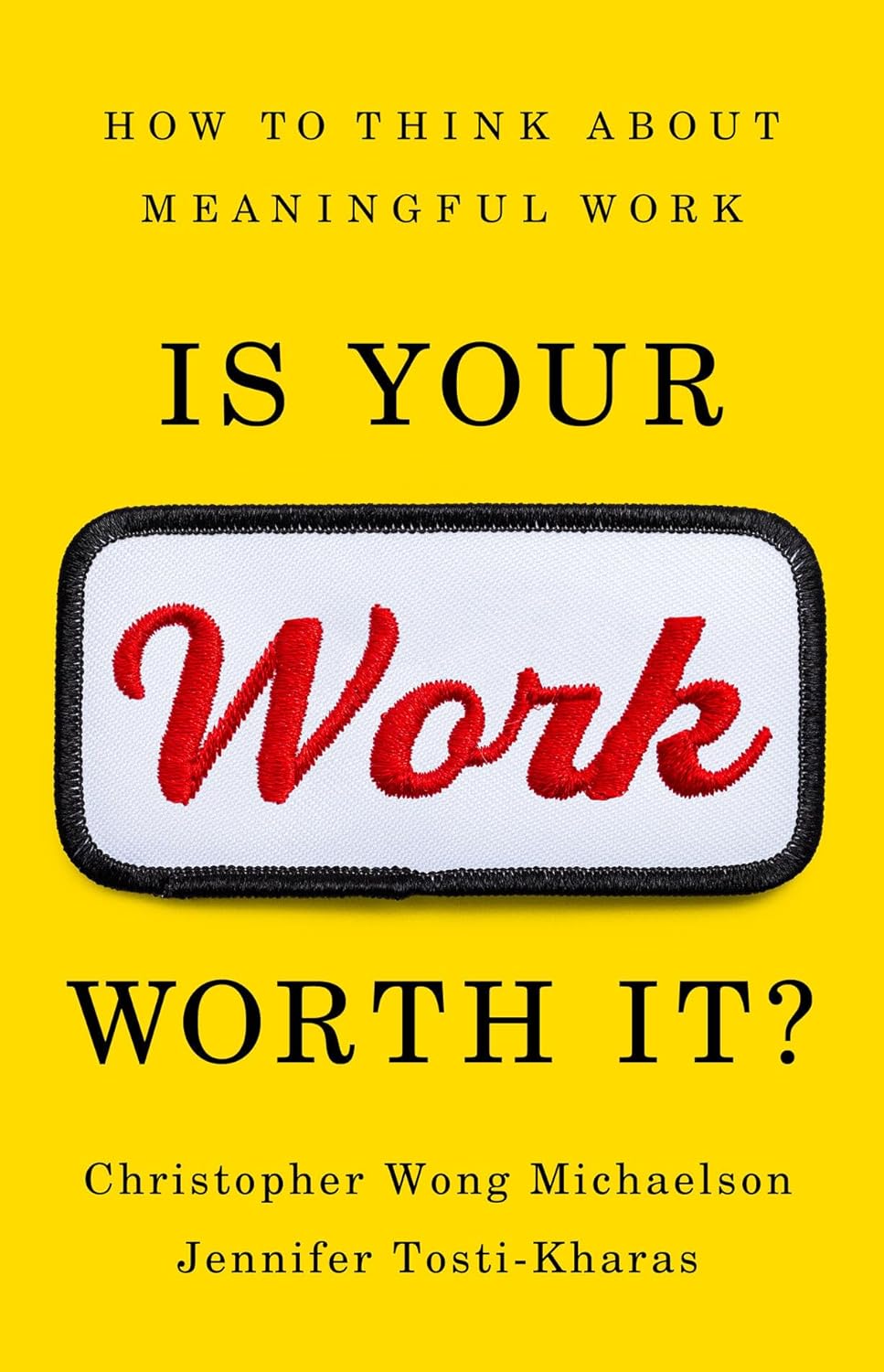
In Is Your Work Worth It? Christopher Wong Michaelson and Jennifer Tosti-Kharas address the question of what makes work worthwhile, rather than specifically meaningful – meaningful work being the subject of their book in this area (The Meaning and Purpose of Work). Naturally, the meaningfulness or otherwise of work is considered in this volume, but it is important to realise that the focus of this work is different and it is not simply a more ‘popular’ version of their more academic book. It is not only the focus of this book that differs; the volume is aimed at a much broader, non-academic readership and as such, the approach taken is significantly different, too. The book covers a good deal of content in a relatively short space, which makes a detailed summary of each chapter impossible in a review. Therefore, the focus here will be on particular chapters and the purpose of the book as a whole.
The first chapter defines work as ‘purposeful, effortful, and recognized by society as work’ (page 26) – which means that it often merits pay – and then proceeds to consider the nuances of each element of the definition, adding that often, what we consider to be some of the most important work of all is either not well-remunerated or is completely unpaid. The second chapter offers an interesting examination of the reasons for which we work, whether for intrinsic rewards such as fulfilment, or for money (perhaps to support a family or to fund some fulfilling endeavour outside our working lives). At one point, it is suggested that perhaps we ought to consider not whether we are making enough to realise our projected ends, but whether those ends we are working towards are worth the work that we are doing (page 48). The authors introduce the three-orientations to work – job, career and calling – and it is here that the idea of meaning first enters the discussion. However, the notion of meaning is not defined clearly and there seems to be some slippage in the discussion between work being worthwhile and work being meaningful, though the two are of course connected (and may indeed be inseparable). What seems to emerge is that whether work is worthwhile or meaningful turns on the role that work plays in within a person’s life ‘as a whole’ (page 44). Once work has a significant role to play in a person’s life, whether for its own sake or because of what it enables, it becomes worthwhile and (perhaps indirectly) meaningful. It follows that any number of reasons given for working can make work meaningful and there is an endless variety of worthwhile values that motivate working. With this in mind, the authors advise against a hierarchical attitude to the different orientations to work by which we might always privilege the idea of work as a calling, just because it carries with it the idea of fulfilment or meaning for the worker. Moreover, we need to look beyond the perspective of the individual who works: while the individual might find his job mundane and unfulfilling, those who depend on him might see matters rather differently. Perhaps what matters, therefore, is not some deeply meaningful vocation, but the questions raised by our reasons for working and who it is that we work for.
Subsequent chapters consider the questions of how much we work and for how long, address the notion of worth and the idea of work as a calling, and examine the conception of ‘necessary’ or essential work. Frequently raised are the discrepancies that exist between different types of work, with work that we recognise as essential often being the least flexible and the least well paid. Readers are invited, therefore, to consider the conflation of ‘worth’ with ‘monetary value’ and to ask what might change in our working culture – as a society or in our organisations – so that we see our work as ‘worth doing’, rather than longing for (a time when we do) no work at all. With regard to the notion of calling, the authors offer a series of questions that demonstrate the need to take a longer-term, balanced view of work and its worth, and to think about ways of rendering the present more ideal instead of romanticising the future. Similarly, Chapter 7, in its engagement with the idea of purpose, poses a set of questions aimed at determining the individual’s conception of purpose at work. Interestingly, what emerges – apart from the fact that it is not easy to respond to all of them with clarity – is that one can rarely ‘have it all’ when it comes to finding purposeful work, as is demonstrated by a series of short case studies that close the chapter. The two final chapters examine the idea of leaving a legacy and explore the absence of work, asking what we are to do – both as individuals and a society – in a world without work.
The book’s titular question: Is Your Work Worth It? appears to invite the flippant response: ‘Yes, otherwise I wouldn’t do it!’ However, such a reply overlooks the point of the book, which is to consider the question: Why (or perhaps: Why not)? As the authors frequently acknowledge, to be able to reflect on this question is in itself something of a luxury. Many people work to make ends meet and cannot afford not to do what they do. The authors recognise this fully and state very directly that the obligation to meet basic needs and support others is one (perfectly decent) reason among others to work – one which can and does make work both meaningful and worthwhile, even if we don’t find the work itself personally fulfilling. What the book asks us to consider is how this kind of value measures against others and what it is that we want from our work.
In this respect, it is successful. With its clear prose and rich examples, it is a starting point for reflection rather than a book that develops particular concepts in depth. Through stories and illustrations, it raises questions about a particular notion connected with work and worth, considers difficulties or different approaches to that idea, and so leaves the reader to think about the issue for him or herself. For example, in the chapter on purpose, the authors do not assert that this is purposeful work, or list careers that can rightly be considered purposeful. Instead, they talk about purpose in broad terms and different ways in which one might set about establishing or discovering purpose in work oneself. In consequence, those looking for a single line of argument or a particular narrative throughout the book will be disappointed – but that is not the authors’ purpose. As they state in the introduction, their aim is not to tell readers what work to do, but to encourage them to do work that is ‘worth it’, whatever that may be: ‘It is about the priority of work worth doing in a life worth living’ (page 13).
At times, it is not entirely clear what the relevance of some discussions is, or why the authors are raising a particular question or presenting an example. In many chapters, the reader is presented with direct questions aimed at facilitating personal reflection on the issues raised. These help to indicate the significance of what is being discussed, whether to the chapter more broadly or the book’s overall concern, and more reminders of this kind would have been welcome. Nevertheless, there are connections between chapters and the book rewards sustained reading – perhaps slowly and more than once. That is not to say that it is hard to follow: it is in fact eminently readable. Revisiting the book, however, or specific chapters of interest, should enable the reader to identify these connections more clearly (for instance between the chapters on loving one’s work and on purpose) and so deepen his or her thinking on a given question or theme.
In the introductory chapter, the authors suggest that the book is for anyone who works, at any point in his or her career, or anyone facing work, a career transition or retirement. It considers the sacrifices that work requires of us and why we make them – what it is that makes work as part of our lives worthwhile. In this, they are surely right. While the book does not provide answers, it offers plenty of material for reflection and is to be recommended as a starting point for anyone who ever thinks about the point of their work, or what it is that makes it worth doing.
‘Is Your Work Worth It? How to Think About Meaningful Work’ by Christopher Wong Michaelson and Jennifer Tosti-Kharas was published in 2024 by Public Affairs (ISBN: 978-1-541-70340-7). 304pp.

Neil Jordan is Senior Editor at the Centre for Enterprise, Markets and Ethics. For more information about Neil please click here.
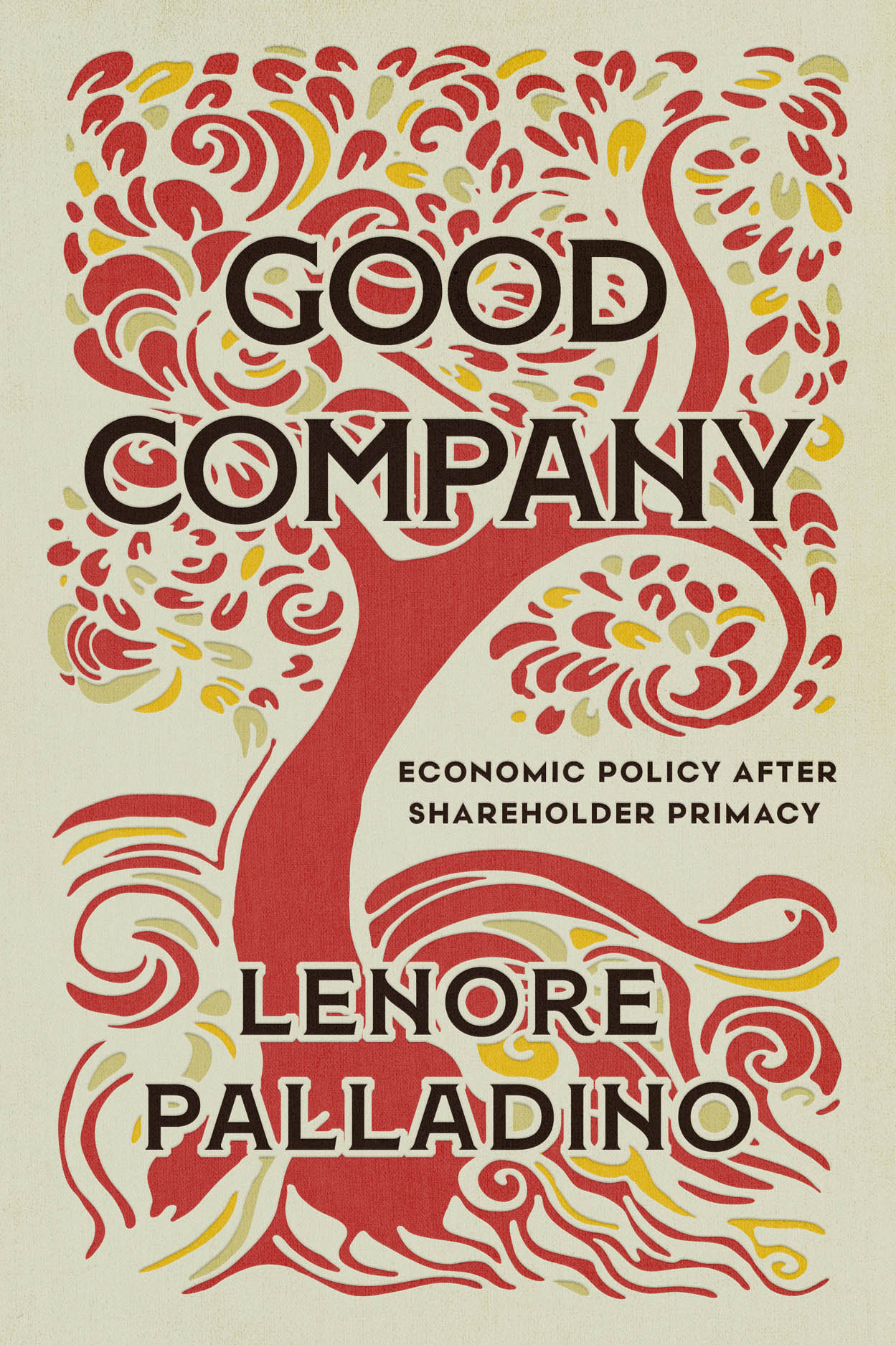
Lenore Palladino is Associate Professor of Economics and Public Policy at the University of Massachusetts Amherst. She suggests that a good company is one that is ‘innovative and responsible’ (page i). She believes that large corporations focus ‘too little on creation and too much on distribution’ (page 2) and she places the blame squarely on the shoulders of the doctrine of ‘shareholder primacy’. In Good Company she, therefore, sets out ‘to provide a sketch of how ending shareholder primacy and reorienting corporate decision making towards productivity would work in practice’ (page 1) and to propose policies to ‘reorient corporations away from shareholder primacy and toward innovation’ (page 9).
Extraordinarily, however, the book provides little evidence in support of either the link between shareholder primacy and a lack of innovation or the efficacy of her proposed policies in promoting innovation. Instead, there are many indications of other policy objectives, leaving a strong impression that Palladino’s objective is not really innovation but the implementation of a left-wing socio-economic agenda.
The book contains many left of centre linguistic markers such as references to ‘elites’, ‘progressive legal scholars’ and ‘industrial democracy’. It is also littered with gratuitous references to matters that are, at best, peripheral to the subject matter. The number of such references to race verges on the obsessive (there being five before the end of chapter 1!) and these are joined by various references to climate change and a throwaway claim that ‘hospitals and schools should be fully public’ (page 9). Furthermore, Palladino seems to regard many of her propositions as already proven since she often simply asserts them or quotes other like-minded authors as if stating their opinion is sufficient to establish her point. The more striking unproven assertions include the claim that ‘Shareholder primacy has led to extreme wealth inequality in the United States’ (page 50) and the ex-cathedra statement that ‘companies with the most market power are not paying nearly enough in taxes’ (page 77). Like her basic contentions regarding innovation, neither of these propositions is self-evident.
Leaving aside issues in relation to her specific proposals, Palladino’s overall thesis is built on sand. She attacks a version of the doctrine of ‘shareholder primacy’ that considers the only duty of directors to be the advancing of the financial interest of shareholders regardless of all other considerations. Of course, this version has been advocated but there are other versions that incorporate nuance that, at least, mitigates some of the issues that Palladino perceives, including the concept of ‘enlightened shareholder value’ that is enshrined in Section 172 of the UK Companies Act 2006. In its more extreme forms, ‘shareholder primacy’ is flawed but this should not cause us to dismiss the concept that the shareholders of a company are its owners and that the directors have a duty to promote the success of the company for the benefit of its shareholders within the context of other legal and, equally importantly, ethical duties.
Palladino admits that her book is US focused but this does not excuse her failure adequately to engage with non-US experience. In some cases, she appears to have misunderstood foreign laws and practices. For example, she asserts that in Germany workers represent one-third to one-half ‘of the directors’ of companies falling within the ambit of the co-determination laws (page 85) but in fact worker representation in Germany is at the level of a supervisory board that is not permitted to manage the company and that has carefully circumscribed powers. More seriously, Palladino fails to address the question why, if (as she suggests) some of the reforms that she advocates have been implemented in European countries, those countries appear to have a worse record in innovation than that of the United States, which is generally regarded as among the more innovative economies of the world.
Most seriously of all, Palladino addresses herself solely to publicly listed corporations. She recognises this and says that the next phase of her research will consider the growing importance of the private markets but she does not appear to recognise that the time has passed when one could credibly discuss issues to do with the businesses and governance of major corporations while considering only those that are publicly listed. Huge corporations are now owned by a variety of financial sponsors (ranging from sovereign wealth funds to venture capital houses and family offices) and one cannot analyse corporate failings and propose solutions to these failings without considering such corporations.
Palladino presents proposals relating, among other things, to: US federal incorporation and the licensing of major corporations; a ‘real seat’ doctrine of state incorporation (that is, a requirement that a corporation be incorporated in the US state with which it has the closest connection); stock buy-backs; the taxation of corporations (including a ‘wealth tax’ on market value); shareholder taxation (including a proposal that tax be paid on unrealised gains); employee-elected representatives on corporate boards; changes to the duties of board members; works councils; employee equity funds owning perhaps 20% of corporations; and proposals relating to asset managers, including the establishment of a public asset manager.
Many of her proposals deserve, and in other books have received, detailed consideration and have been the subject of extensive debate. A further contribution to the debate might have been helpful but, adequately to cover all of Palladino’s proposals, the book would have had to be several times longer than Good Company. As it is, Palladino has tried to cram her analysis and proposals into 135 pages and the result is a deluge of contentious assertions and proposals, few of which are adequately worked through. On occasions (for example, in relation to the composition of employee representation on corporate boards), she acknowledges the complexities and the need for further thought but all too often she does not acknowledge these things and, in any event, she fails to distinguish between issues that are mere points of detail and those that raise questions that pertain to the viability, effectiveness or potential adverse consequences of her proposals.
Her discussion of what she perceives to be the evils of share buy-backs in the USA illustrates many of the book’s frustrating weaknesses. She suggests that buy-backs ‘are used to prop up share prices while contributing nothing to corporate productivity’ (page 63) and some of her concerns have an element of truth. In particular, there are legitimate concerns about the opportunity provided for insider dealing and market manipulation. However, whilst there is evidence of wrongdoing, there is little that suggest that wrongdoing is endemic or that it necessitates anything more than consideration of the detail of the applicable regulations. In fact, it is strongly arguable that the real problem is the structuring of executive share option and other incentive packages rather than the buy-backs themselves.
Palladino argues that limiting buy-backs would leave more money in corporations and thus lead to greater innovation but it is by no means clear why this should be the case and she presents no supporting evidence. Money left in a corporation might be used on mergers and acquisitions, a reduction of capital or simply the payment of greater dividends, rather than for innovation.
Palladino also fails adequately to address possible unintended consequences of her proposals. Sometimes she briefly alludes to the possibility of such consequences (for example, she recognises that employee equity funds might result in increased agitation for larger dividends and thus a reduction in the amount of capital available for investment [page 111]). However, there are glaring omissions. In particular, her discussion of the ways in which employees and their representatives might have a say in relation to the running of corporations never addresses the evidence of employee conservatism and, perhaps more importantly, the conservatism of trade unions that historically, in many places, acted as an impediment to the very innovation that Palladino purports to be seeking.
Sadly, despite dealing with important issues, Good Company does not advance current debates regarding corporate purpose and corporate governance. It is likely only to convince those who are already signed up to its underlying philosophy. Those who want to understand the relevant issues and consider carefully the pros and cons of possible reforms need to look elsewhere.
‘Good Company: Economic Policy after Shareholder Primacy’ by Lenore Palladino was published in 2024 by The University of Chicago Press (978-0-226-83650-8). 135pp.
 Richard Godden is a Lawyer and has been a Partner with Linklaters for over 25 years during which time he has advised on a wide range of transactions and issues in various parts of the world.
Richard Godden is a Lawyer and has been a Partner with Linklaters for over 25 years during which time he has advised on a wide range of transactions and issues in various parts of the world.
Richard’s experience includes his time as Secretary at the UK Takeover Panel and a secondment to Linklaters’ Hong Kong office. He also served as Global Head of Client Sectors, responsible for Linklaters’ industry sector groups, and was a member of the Global Executive Committee.
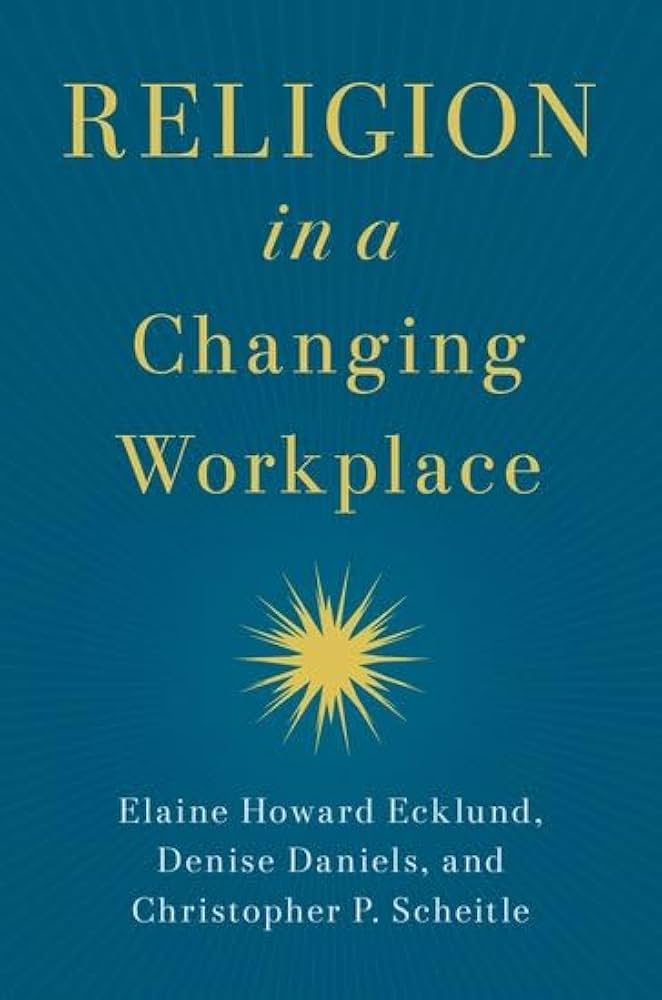
This book provides the results of research that was conducted by three academics who wanted to better understand the impact of allowing employees to demonstrate their religion in the workplace; the authors refer to this as workers bringing their whole selves into the workplace. The research questions were on how and when faith and religion are demonstrated in the workplace, what the positive and negative outcomes are of these demonstrations, and what type of professions or workplace environments are most tolerant to those who have a desire to be all of who they are in the workplace. Over 13,000 people in the U.S. completed the survey over a three-year time period; the survey respondents were from many different religious groups, including Christians, Muslims, Buddhists, and Jews, in addition to those who identified themselves as having no faith at all. Overall, the authors were attempting to identify what the potential results are for organizations and the individual employees if the employees are allowed to be fully authentic at the workplace. The references used as a foundation for this study indicate that employees are ‘more committed, motivated and act in ways that support the organization’ (page 10) when they bring all of themselves to the workplace, and the first chapter explains why this research is necessary.
There are ten chapters in the book, eight of which discuss the different results of the research. Each chapter begins with a mini-story from one of the survey participants and then the authors proceed to further explain the point made in the anecdote with the results of the questions that were asked in the multi-question survey. There is at least one table or figure in each chapter demonstrating the results, cross-tabulated with different demographic characteristics; these are very helpful for gaining a better understanding of the differences between the different workplace and personal characteristics. Every chapter ends with a section called The Bottom Line, which provides a quick summary of the main points made in the chapter. Each chapter also has many references to other research that relates to the topic being discussed (the full reference list fills six and half pages) and there are many notes that add to the discussion of the chapter. There are five appendices at the end of the book that explain the research methodology and provide the questionnaire that was used to gather the data.
Chapter 1 introduces how the book is structured and the point of the research. Chapter 2 adds a further foundation to the purpose of the research by identifying the fears that leaders may have when allowing faith practices and religious talk in the workplace. Three different fears are identified. These include the possible marginalization of some of the workers when religious faith is expressed, the conflict that could occur between workers having different faith perspectives, and the potential emotional separation workers may feel when not being allowed to fully be themselves in the workplace.
Chapter 3 identifies all the different ways that faith is expressed at work. This discussion includes the impact that different factors, such as position in the organization, size of the organization, culture of the organization, and individual characteristics have on the ways in which workers express their faith and their confidence in doing so. Chapter 4 addresses an interesting question of workers viewing themselves as having a spiritual calling for the work they are doing. This aspect was studied because other research indicated that ‘having a sense of calling was correlated with better coping with work problems, as well as overall lower stress and depression rates’ (page 43) and so many different aspects of calling are discussed in this chapter. Chapter 5 takes this discussion a step further and identifies how allowing religion in the workplace can bring meaning and purpose to a worker’s job tasks and work environment.
Chapter 6 discusses the relationship between faith and different aspects of ethical behaviour, such as questioning authority, advocating for self and others, and making change within the organization. The authors provide many interesting individual anecdotes and statistics related to ethical behvaviours demonstrated by different professions and types of organizations. Chapters 7 and 8 begin the discussion of religious discrimination and harassment, and the realistic accommodations that need to be present if religious expression is encouraged in the workplace. The authors identify the factors affecting where and when discrimination and harassment are more likely to occur; these include where in the country these workers live and work, whether the religious group is a minority within the workplace, whether there is a particular societal perception of a religious group (the authors speak about the challenge Muslims have within the U.S. since 9/11), and the leader’s perception of and experience with different religions. The authors also challenge their own research results in relation to the question of whether religion is the factor that is causing discrimination and harassment; they wonder if the cause is another demographic factor such as gender or ethnicity. The discussion on accommodation includes the influence of the human rights legislation in the U.S. and how this might impact the actions and reactions in the workplace.
Chapter 9 brings one further point to the discussion on accommodating faith in the work environment. This chapter discusses the addition of family into the equation of whether employees feel comfortable and supported in bringing all of themselves to the workplace. One interesting demographic factor noted was that employees who are more religious are more likely to be married and have children. Due to this factor, this group identified more work-life balance issues. Also, the authors discovered that in those who identified themselves as religious, there was a significant difference between the percentage of men and women in the workplace, with women participating less than men. There was also much more gender traditionalism demonstrated among these workers.
The last chapter provides a good summary of what organizations and leaders should do if they want their workers to bring their whole selves to work. The authors identify, once again, the benefits of workers having the freedom to express their faith in the workplace. They also, though, acknowledge some of the challenges that organizations may experience when allowing faith in the workplace, and provide a brief description of six things an organization can do to reduce the downsides of creating a faith-tolerant workplace.
This would be a very interesting book for someone working in an HR department to read, as they could refer to the research when recommending certain policies and procedures or proposing a shift in the organization’s work culture. This book is also a great reference for any academic studying or teaching in the social sciences or business fields. The empirical research is solid and provides much evidence for recommending freedom of faith within the workplace. The main challenge I see with this book, however, is that all the data was gathered from those working in the U.S. and thus the conclusions and recommendations may only be applicable to organizations in the U.S. The objective of the research study was to understand the benefits of allowing religion to be demonstrated in the workplace, so if this study was replicated in Europe, Asia, or Africa the results could benefit organizations that operate within a global environment.
‘Religion in a Changing Workplace’ by Elaine Howard Ecklund, Denise Daniels, and Christopher P. Scheitle was published in 2024 by Oxford University Press (ISBN: 978-0-19-767501-4). 201pp.
 Andrea Soberg is a retired professor of human resource management from Trinity Western University in Canada. She continues to be active within the global academic and business community by researching, writing, and assisting organizations that have a focus on business as mission.
Andrea Soberg is a retired professor of human resource management from Trinity Western University in Canada. She continues to be active within the global academic and business community by researching, writing, and assisting organizations that have a focus on business as mission.

As the authors of The Meaning and Purpose of Work point out, most of us will probably spend more of our lives working than doing anything else, such that work has the potential to be our most meaningful contribution to the world, but also that which causes us the greatest misery. The book is shaped around the idea that work occurs at three levels: individual, organisational and systemic, and throughout, the authors return to the trade-off between the personal rewards of work, whether extrinsic (such as remuneration) or intrinsic (such as a feeling of fulfilment), and its societal worth (as with work that serves others). All of these are significant determinants of meaning and as such, the main focus of the book – emphasised at the very end – is on why we work, this being the question that must inform other, more pragmatic questions about what to do, where or for what duration.
The introduction raises the question of meaning in work, particularly when tragedies or crises provoke periods of reflection. The first chapter then proceeds to explore ‘a multiplicity of ways in which work can give life meaning and purpose – and a multiplicity of ways in which it can take it away’ (page 7). Here, the authors outline concepts such as ‘market fit’ in relation to meaning, whereby ‘meaning and purpose can emerge from the abstract machinations of the marketplace … in the form of finding real alignment between what the market needs and wants and what we are uniquely fit to supply’ (page 8). They also discuss the importance of self-realisation (or personal fulfilment), service to others (including supporting one’s family), and community (or those with whom we work) if work is to have meaning.
Chapter 2 unpacks fundamental concepts such as work, meaningfulness and purpose and suggests that while our personal perspectives are important when it comes to judging work meaningful, tied as such judgements are to our systems of value, they are not simply statements of preference but are in fact prescriptive – which raises the possibility of our being wrong, for instance if our priorities are mistaken or we are confused about what matters to us. Much therefore depends on our theory of what constitutes meaning(fulness).
Chapters 3 and 4 examine factors that can influence the meaningfulness of work, focusing primarily on the importance of individual perspective and ‘work orientation’. With regard to the latter, whether one sees one’s work as a job, career or calling can have a fundamental impact on levels of satisfaction, fulfilment and identification with one’s work. While the authors recognise that ‘job-crafting’ and changing one’s orientation to work is not a means by which anyone can suddenly transform a tedious job into a rewarding career, their observations highlight the importance of ‘meaning-making’, whilst also acknowledging the fact that the perspectives of others (rather than simply that of the worker) matter, and that the nature of the work itself is often central: ‘Notwithstanding this implication that meaning and purpose are to be found in the worker … it is difficult to deny that there are some features in the world around work that make some work more conducive to cultivating meaning and purpose than others’ (page 60).
Chapter 5 looks at meaningful work in organisations, considering reasons for the shift towards stakeholder value perspectives and the proliferation of company statements of purpose. Comparing work in one of the Big Four accounting firms to that of a small, worker-owned company, the authors recognise that many people (themselves included, previously) do find meaning and value working for large firms, under pressure to produce results. They also acknowledge that large organisations can achieve purposes that matter to individuals who work for them and that what matters when it comes to any stated company purpose is sincerity: ‘ … the organizations in which we often work can fulfill those inspiring purposes, from serving society’s needs to making the world a better place. They can do so at a scale that we could not achieve as individuals, harnessing collective power that enables us to connect our personal meaning and talent to a larger purpose … economic sense and moral sentiments can align together to build organizations that are monetarily successful and provide work that is meaningful to their employees’ (page 81). While organisations can strip the meaning from work and leave employees feeling under-valued in repetitive, tedious work, they can also create communities and serve valuable purposes. As ever, much depends on the values of the individual, but in organisations, a good deal is down to the approach of the leaders.
Chapter 6 raises the question of how market and state value and put a price on work (and life) according to its ‘market fit’ or societal benefit. There is rather less in the way of conceptual discussion in this chapter and while the reader can extract from the detailed case studies the tension between personal and societal values that confer meaning on work, a closer, more guided discussion of the ways in which our socio-economic system can assign meaning (or otherwise) would have been welcome.
The final chapter considers the future of work and the issues that are likely to arise as work changes, recapitulates earlier material and reinforces the book’s organisation around the three levels of work, offering a series of terms that express functional and moral practices or motivations connected with work at each level.
While brief, The Meaning and Purpose of Work covers a good deal of ground and in returning to certain themes constantly, maintains coherence. Some readers might wonder why, in a book dealing with meaningful work, there is little discussion of the specific rewards and challenges of self-employment, and the acquisition of professional skills seems to receive no attention. However, it is likely that these subjects – and others – could be addressed by the conceptual resources provided, possibly in terms of personal fulfilment or self-realisation. Perhaps more of a challenge is the importance of human dignity as a feature of work. While the authors do hint at this in places with terms such as ‘noble’ and considerations of the importance of ‘feeling valued’, this fundamental value connected with work – one likely to shape many conceptions of its meaning – is not discussed directly at all. While the foundations for a discussion of dignity may well be present, if the concept cannot be reduced to some other notion delineated in the book, such as ‘self-realisation’ or ‘recognition’, many would consider the absence of any consideration of dignity to be a significant oversight.
Nevertheless, the book is certainly to be recommended. The Meaning and Purpose of Work is very accessible and well written. Much of the discussion is conceptual but this is always clear and illustrated with well-chosen examples, while engagement with the major literature is in no way over-bearing. The authors do not seek to tell readers what meaningful work is and as such, there is no single line of argument to follow throughout. Instead, they invite reflection on what makes work meaningful (or not), and why, both for those engaged in it and those around them – a valuable exercise which is conducted in a measured and balanced fashion. Each chapter contains questions for further consideration or reflection, which suggests that the book is meant for use in seminars. It is likely to appeal to those with interests in philosophy and questions of value in relation to work, and while not intended as an instructional or ‘how to’ book, it would lend itself to being adapted for use in courses or training on subjects such as business purpose or meaningful work.
‘The Meaning and Purpose of Work: An Interdisciplinary Framework for Considering What Work is For’ by Christopher Wong Michaelson and Jennifer Tosti-Kharas was published in 2024 by Routledge (ISBN: 978-1-032-30933-0). 121pp.

Neil Jordan is Senior Editor at the Centre for Enterprise, Markets and Ethics. For more information about Neil please click here.
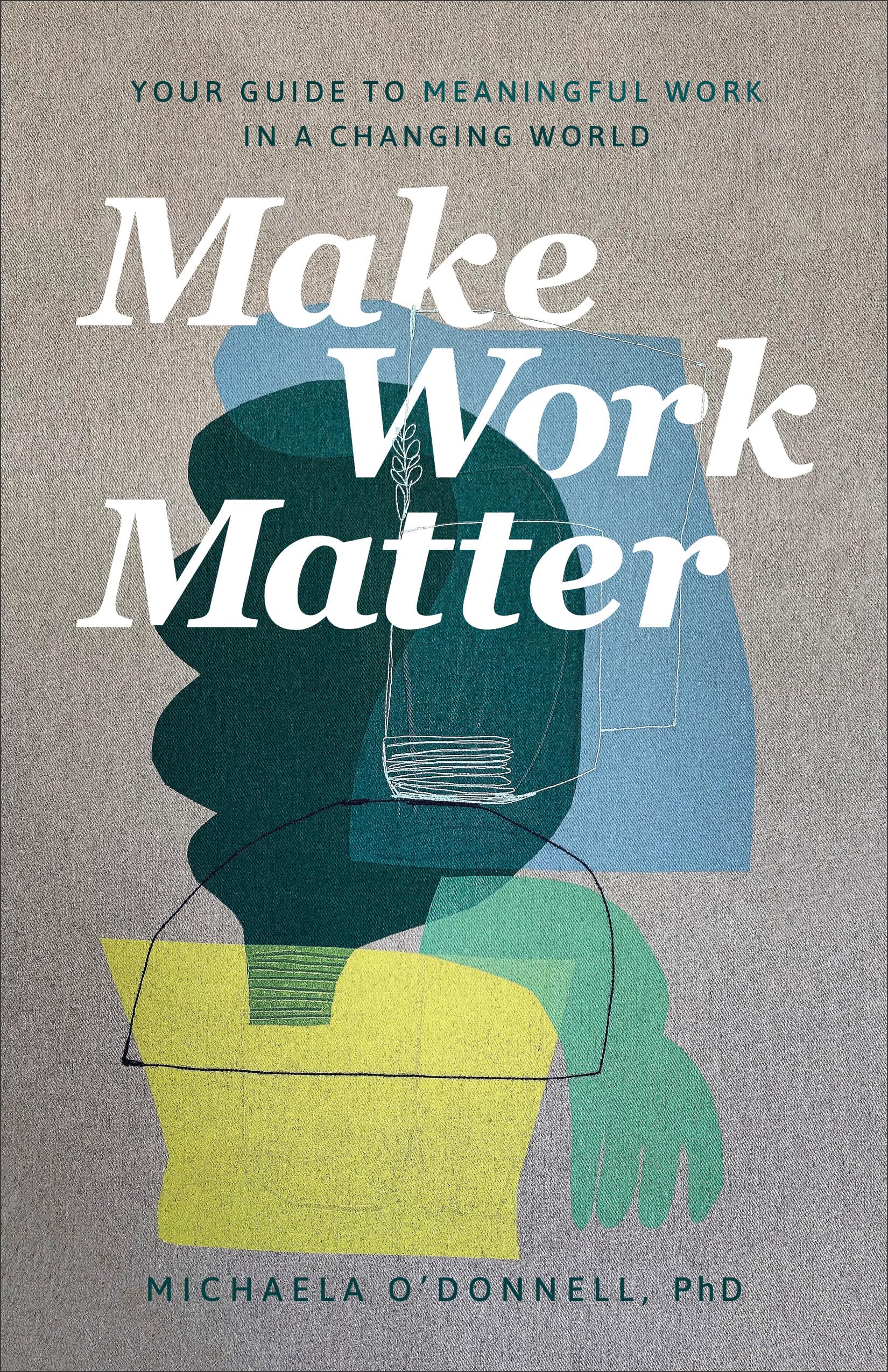
With the subtitle of this book being ‘Your Guide to Meaningful Work in a Changing World’ the reader would assume that O’Donnell’s book would provide guidance on how we can be better at our jobs and find fulfillment with the paid work that we do. This book, however, does not really achieve this end. This is not to say that this is not a good book to read, but the reader needs to understand what they will get out of this book before reading it. This is a book that can assist the reader in acknowledging and using the gifts and talents God has given us for the work we do. The work and business examples that are provided in each chapter evolved from the research that the author conducted while completing her doctoral dissertation. This book is written by a woman who provides many examples of the challenges women have when balancing life and work. Each chapter includes many stories of leaders, employees, and entrepreneurs and their experiences with their work and work environment.
The book is written with three distinct sections, each having several chapters that expound on the focus of the section, with each chapter ending with some exercises that assist with the practical application of what was written about in the chapter. The first section is called ‘Where Do You Want To Go?’ and includes 3 chapters that discuss the challenges that most people are facing in today’s world of work. (Note that the author is writing for an audience in the developed world and does not include the challenges that someone might experience in under-developed nations). O’Donnell briefly discusses the economy, the new tools and technologies that are now used in work, and the feelings and emotions experienced by workers in today’s organizations. She proposes and challenges dysfunctional beliefs about work that Christians may have and attempts to explain what God’s calling is for our lives. Even though these chapters may set the stage for our current situation they don’t really motivate the reader to read further in the book. The saving grace of this section is Chapter 2, where the author discusses the concept of ‘lean in and let go’ and where she acknowledges that God is in control of our situations. This discussion possibly sets the stage for moving on into the second section of the book where the reader learns more about how to lean in and let go.
The second section of the book is entitled ‘Who Will You Become?’ and has 4 chapters that discuss how to be entrepreneurial in your work and business. In the author’s bio, listed on the back cover of the book, she is identified as an entrepreneur and so she has an understanding of what it feels like to start a business. Throughout the chapters in this section, she uses many of her own business experiences, in addition to the answers to questions she asked entrepreneurs while completing her doctoral research, to explain many of the concepts discussed in these chapters. O’Donnell refers to several significant topics such as the importance of building relationships, understanding creativity, and developing resilience skills. In this section of the book she utilizes many scriptural references to explain how God always uses relationships in the building of His kingdom, how creative the Lord was in the creation of the world and all that is in it, and how Jesus was resilient in all that He endured. The use of some of the biblical references, however, can appear to be forced when relating these to the topics being discussed. One example of this is in Chapter 7 where the author uses the Easter story as a demonstration for building resilience; this application to work in our current situations seems a bit contrived. Since this section of the book was focused on being entrepreneurial in your work, it may appear that this book is written for people who want to start their own businesses; this may cause some readers to feel that this book would not be a guidebook for them in making their work meaningful in a changing world.
The last section of the book is entitled ‘How Will You Get There?’ and includes 4 chapters that focus on having empathy, imagination, and taking risks. This section ends by reflecting on our past and considering how we got to where we are today. In these chapters O’Donnell re-emphasizes our need to be entrepreneurial in all we do and explains good techniques for being a successful entrepreneur. Once again, though, these chapters don’t seem to fit within the main purpose of the book, which is to make any and all work meaningful in a changing world. The thoughts in these chapters could, however, assist entrepreneurs in being more effective and successful in their entrepreneurial ventures, as they deal with their failures and successes.
In conclusion, I found the book hard to read as there seemed to be no clear focus and end goal. Most chapters were well written, but the discussions did not always hang together inside the chapter or with the following chapters. The book did not successfully provide the reader with a conclusion on how to make their everyday work meaningful. The first 3 chapters probably should appear at the end of the book, as they summarize the current situation and demonstrate how all the concepts that are discussed in the following chapters provide some of the needed skills and direction on how to better manage our current work situations. Many of the chapters read like stand-alone essays (or good talks for a conference or podcast), which are good in themselves, but don’t always lead the reader to further knowledge in how to make work matter. The integration of scripture in some of the chapters and areas of focus seemed to be forced and doesn’t provide a cohesive understanding of what was really being meant by the scripture passages being used. Overall, the best chapter in the book is Chapter 6, where there is a wonderful exposition on creativity and God’s role in our ability to create. The author provides many gems in this discussion and causes the reader to truly consider our ability to be continually creative in all we do, remembering that God is the creator and we work with Him in all we create in our lives.
Due to the structure of each chapter including many anecdotes, and the fact that the majority of the references cited were not from academic books or articles, this is not an academic treatise about the integration of faith and work. This could be a good book for a Christian book study in which people in their early career stages have a desire to better understand how to integrate their faith with their work. The questions at the end of each chapter allow for good discussion and could elicit more answers as to how to make work matter, and these answers could actually create a guide-book for creating meaningful work in a changing world.
‘Make Work Matter: Your Guide to Meaningful Work in a Changing World’ by Michaela O’Donnell was published in 2021 by Baker Books (ISBN: 978-5-40-90160-6). 234 pp.
 Andrea Soberg is a retired professor of human resource management from Trinity Western University in Canada. She continues to be active within the global academic and business community by researching, writing, and assisting organizations that have a focus on business as mission.
Andrea Soberg is a retired professor of human resource management from Trinity Western University in Canada. She continues to be active within the global academic and business community by researching, writing, and assisting organizations that have a focus on business as mission.